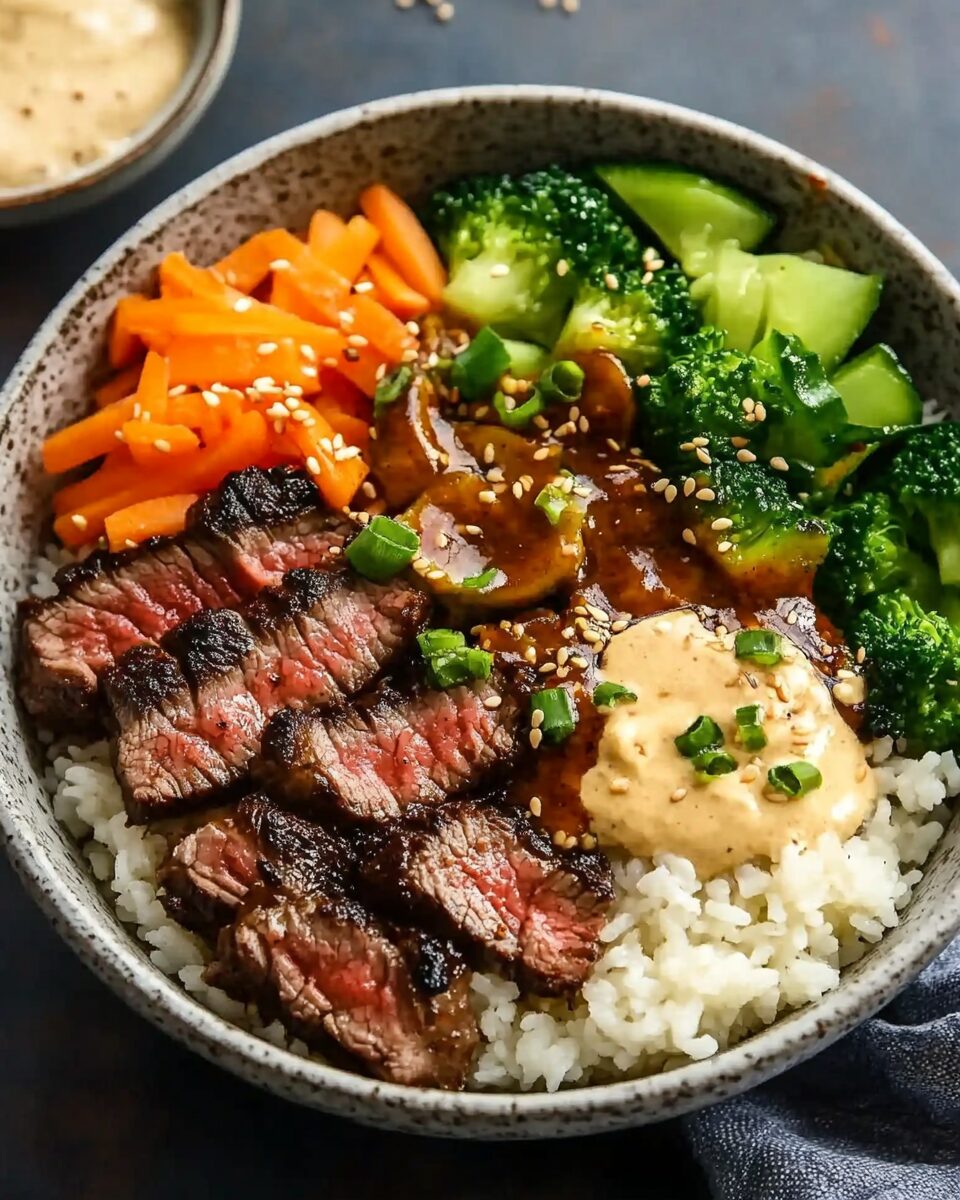These Hibachi Steak Bowls bring the bold flavors of a Japanese steakhouse to your own kitchen. Featuring tender marinated steak, crisp vegetables, fluffy jasmine rice, and a creamy Yum Yum Sauce, this recipe is a complete, well-balanced meal in one bowl. It’s quick to make, easy to customize, and perfect for both weeknight dinners and entertaining guests.
Full Recipe:
Ingredients
For the Steak & Marinade:
-
1 lb ribeye or sirloin steak, thinly sliced
-
2 tbsp soy sauce
-
2 tbsp sesame oil
-
1 tbsp minced garlic
-
1 tbsp minced ginger
Vegetables:
-
1 cup chopped zucchini
-
1 cup sliced mushrooms
-
1 cup julienned carrots
-
2 tbsp butter
-
Salt and pepper, to taste
Rice Base:
-
3 cups cooked jasmine rice
Yum Yum Sauce:
-
½ cup mayonnaise
-
1 tbsp ketchup
-
1 tsp rice vinegar
-
1 tsp paprika
-
½ tsp garlic powder
-
½ tsp sugar
-
1–2 tbsp water (to adjust consistency)
Toppings:
-
1 tbsp toasted sesame seeds
Directions
1. Marinate the Steak:
In a bowl, mix soy sauce, sesame oil, garlic, and ginger. Add the sliced steak and marinate for 15–20 minutes.
2. Cook the Steak:
Heat a skillet or wok over medium-high heat. Sear the marinated steak for 3–4 minutes until browned. Remove and set aside.
3. Sauté the Vegetables:
In the same pan, melt butter. Add zucchini, mushrooms, and carrots. Sauté for 4–5 minutes until tender-crisp. Season with salt and pepper.
4. Make the Yum Yum Sauce:
In a small bowl, whisk together mayonnaise, ketchup, rice vinegar, paprika, garlic powder, sugar, and water until smooth.
5. Assemble the Bowls:
Divide jasmine rice between bowls. Top with sautéed vegetables and steak. Drizzle with Yum Yum Sauce.
6. Garnish and Serve:
Sprinkle with sesame seeds and serve immediately.
Nutrients (Per serving, based on 4 servings)
-
Calories: 485 kcal
-
Protein: ~27g
-
Fat: ~28g
-
Saturated Fat: ~7g
-
Carbohydrates: ~33g
-
Sugar: ~6g
-
Fiber: ~2g
-
Sodium: ~850mg
Why This Recipe Is a Weeknight Winner
Quick, flavorful, and filling, Hibachi Steak Bowls check every box for a successful weeknight dinner. The components cook fast and come together seamlessly, especially if you’ve got your rice cooked in advance. A brief marinate for the steak and a simple sauté for the vegetables is all it takes to bring the meal together. The Yum Yum Sauce, which is a blend of pantry staples like mayonnaise, ketchup, and spices, adds a luscious finishing touch that ties everything together.
Because everything cooks in a single pan or wok, cleanup is minimal—perfect for busy evenings. Despite how quickly it comes together, the dish feels elevated and indulgent, making it a fantastic option for both casual nights and more special occasions.
Restaurant-Style Steak Without the Price Tag
Dining out at a hibachi steakhouse is always an experience, but it can come with a hefty bill. With this recipe, you get all the signature flavors—savory garlic-ginger steak, buttery vegetables, and that famous creamy sauce—without ever leaving your kitchen. By using affordable cuts like sirloin or even flank steak, and stretching the meat with lots of veggies and rice, you can serve an elegant, satisfying meal for a fraction of the cost of eating out.
Thinly slicing the steak ensures it cooks fast and stays tender, especially after soaking in the sesame oil and soy sauce marinade. This technique also mimics the sizzling hibachi grill style that locks in flavor quickly over high heat.
A Balanced Bowl of Texture and Flavor
One of the most appealing aspects of these Hibachi Steak Bowls is the harmony of textures and tastes. The rice serves as a neutral, fluffy base that supports the richness of the steak and sauce. The sautéed vegetables—zucchini, mushrooms, and carrots—offer a crisp, earthy contrast to the umami-packed meat. The Yum Yum Sauce adds creaminess and a hint of tang and spice that brings all the elements together.
Every bite offers a different combination of textures—chewy, creamy, crunchy, and tender—making the dish not only delicious but also deeply satisfying. It’s the kind of meal you’ll want to savor slowly, appreciating how every layer contributes something important.
Customizable for Any Diet or Preference
Hibachi Steak Bowls are incredibly flexible. Want a lighter version? Use cauliflower rice instead of jasmine rice, and lean cuts of beef like top sirloin or even chicken breast. Looking for a vegetarian option? Swap the steak for tofu or tempeh, marinate it the same way, and sear until crispy. You can also boost the veggie count with bell peppers, broccoli, snow peas, or edamame.
Craving heat? Add a pinch of chili flakes or sriracha to the Yum Yum Sauce. Prefer a richer bowl? Stir in avocado slices, a drizzle of toasted sesame oil, or a fried egg on top. The base recipe is a canvas, ready to be painted with your favorite flavors and ingredients.
Great for Meal Prep and Leftovers
One of the biggest bonuses of this recipe is how well it works for meal prep. Make a double batch of steak, rice, and vegetables, then portion everything into containers for ready-to-go lunches or weeknight dinners. The Yum Yum Sauce can be stored separately and drizzled on just before serving to keep things fresh and flavorful.
Unlike many other dishes, this bowl tastes just as great reheated, making it ideal for those who want to prep ahead without sacrificing flavor or texture. The flavors even deepen slightly overnight, meaning tomorrow’s lunch might be even better than tonight’s dinner.
Tips for Perfect Hibachi Bowls at Home
To recreate that authentic hibachi sear at home, make sure your skillet or wok is hot before adding the steak. Don’t overcrowd the pan—cook in batches if needed to avoid steaming the meat. Searing quickly over high heat helps develop those flavorful, caramelized edges without overcooking.
Use day-old rice for the best texture. Freshly cooked rice tends to be soft and sticky, while rice that has cooled in the fridge holds up better and provides a fluffier base. If using canned pineapple or other fruits, be sure to drain them thoroughly to avoid watery results.
For extra flavor, consider toasting your sesame seeds and adding a squeeze of lime or lemon over the finished bowl. The added brightness makes the dish even more vibrant.
Why You’ll Want to Make This Again and Again
This dish offers everything a great meal should: bold flavor, nourishing ingredients, customizable components, and visual appeal. It’s satisfying without being heavy, colorful without being complicated, and indulgent without being unhealthy. It’s also a fun way to bring a bit of culinary entertainment into your own kitchen—no teppanyaki grill or flaming onion volcano required.
Hibachi Steak Bowls are the kind of meal that turns a regular evening into something special. They feel homemade and wholesome but still carry that little spark of restaurant magic, reminding you that great food doesn’t need to be complicated.
Serving Suggestions to Complete the Experience
To turn this bowl into a full Japanese-inspired meal, serve with a side of miso soup or a small seaweed salad. A cup of hot green tea or a sparkling yuzu drink pairs perfectly. For something sweet afterward, consider fresh sliced fruit or a small scoop of green tea ice cream.
If you’re entertaining, set up a build-your-own hibachi bowl station. Provide bowls of rice, vegetables, steak, sauce, and toppings like sesame seeds, chopped scallions, or chili oil so guests can customize their meals.
Conclusion
Hibachi Steak Bowls bring the excitement and flavor of a Japanese steakhouse meal right to your kitchen table. With tender marinated steak, crisp vegetables, fragrant jasmine rice, and a velvety Yum Yum Sauce, each bowl is a flavorful, balanced masterpiece that satisfies from the first bite to the last.
Quick to make, easy to adapt, and stunning to serve, this recipe is perfect for busy weeknights, cozy date nights, or impressive dinner parties. Once you’ve tried it, it’s sure to become a regular in your meal rotation—proof that restaurant-quality meals are completely achievable at home.

